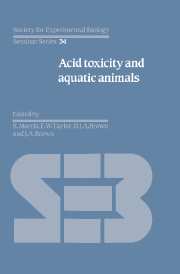Book contents
- Frontmatter
- Contents
- Contributors
- Units, Symbols and Formulae
- Preface
- Introduction: The causes and consequences of surface water acidification
- Invertebrate communities in acid streams
- Fish survival in acid waters
- Field studies on fisheries in acid waters in the UK
- Episodic changes in water quality and their effects on fish
- Acid–base regulation in fishes: 1. Mechanisms
- Acid–base regulation in fishes: 2. Biological responses and limitations
- Intracellular pH regulation and the effects of external acidification
- The physiological problems of fish in acid waters
- Laboratory studies on invertebrate survival and physiology in acid waters
- The physiological problems of crayfish in acid waters
- The effects of hydrogen and aluminium ions on fish gills
- The combined effects of pH and trace metals on fish ionoregulation
- Endocrine responses to acid stress in fish
- Commentary and conclusions
- Index
The effects of hydrogen and aluminium ions on fish gills
Published online by Cambridge University Press: 05 February 2012
- Frontmatter
- Contents
- Contributors
- Units, Symbols and Formulae
- Preface
- Introduction: The causes and consequences of surface water acidification
- Invertebrate communities in acid streams
- Fish survival in acid waters
- Field studies on fisheries in acid waters in the UK
- Episodic changes in water quality and their effects on fish
- Acid–base regulation in fishes: 1. Mechanisms
- Acid–base regulation in fishes: 2. Biological responses and limitations
- Intracellular pH regulation and the effects of external acidification
- The physiological problems of fish in acid waters
- Laboratory studies on invertebrate survival and physiology in acid waters
- The physiological problems of crayfish in acid waters
- The effects of hydrogen and aluminium ions on fish gills
- The combined effects of pH and trace metals on fish ionoregulation
- Endocrine responses to acid stress in fish
- Commentary and conclusions
- Index
Summary
Introduction
During the last decade a small library of books and papers has accumulated dealing with the effects of acid waters on fish. In this review we shall attempt to discuss and, where possible, interpret a small part of this work in terms of what is known of the physiology of fresh water fishes.
The blood plasmas of freshwater fishes contain around 150 mequiv Na+ and 130 mequiv Cl-l-1 in addition to lower concentrations of other ions, particularly Ca2+, K+ and HCO3-. In contrast, soft fresh waters, in which acidification may be a problem, usually contain less than 0.1 mequiv NaCl l-1 and much lower concentrations of other ions. Although fish obtain some salts from their food, most species, including all salmonids, are dependent on the active uptake of salt from the medium to balance diffusion and urinary losses. Freshwater fishes produce a dilute urine and urinary losses are usually less than 10% of the total losses, most of which take place across the body wall, particularly across the gills, where the blood plasma and external medium are separated by only a thin layer of respiratory epithelium. The gills are also the main site of salt uptake, although in some marine teleosts salt transport takes place at other sites, particularly on the inside of the operculum, and the possibility of salt uptake and loss at other sites in freshwater fishes should not be overlooked.
- Type
- Chapter
- Information
- Acid Toxicity and Aquatic Animals , pp. 201 - 220Publisher: Cambridge University PressPrint publication year: 1989
- 10
- Cited by



